Privacy Please! Using Garden Trellises as Attractive Screens & Dividers
I think almost all of us agree that we don’t like the feeling watched when in our own backyard? We get it. Privacy feels priceless. But sometimes, putting up a solid wall or fence feels… well, a bit unfriendly. Like building a fortress. Big, blank barriers can look harsh. They block views completely, yours and your neighbors’. And they can make a space feel smaller, boxed in.
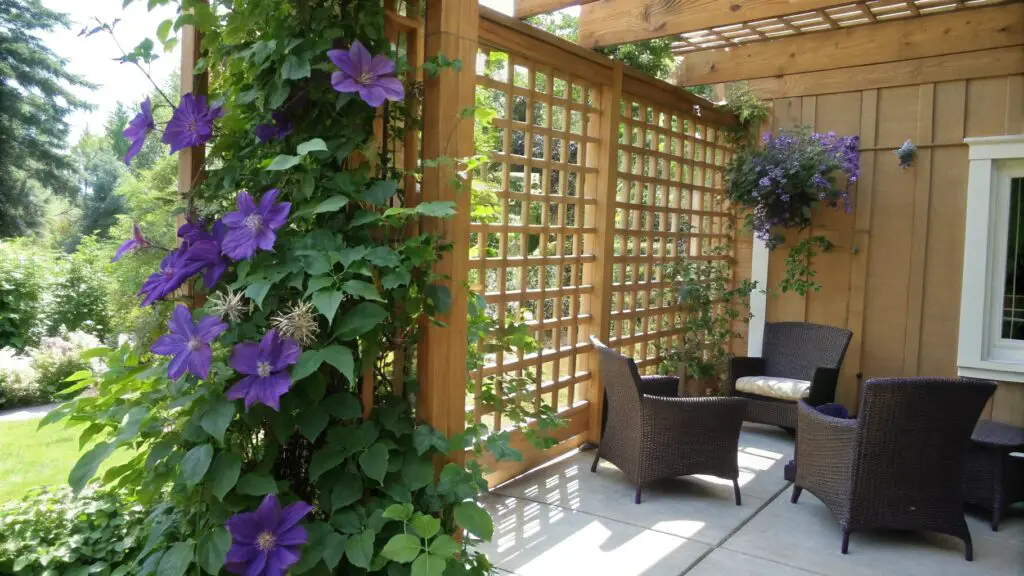
There’s a better way. Think about using a garden trellis for privacy. A trellis is like a framework. It has open spaces. You can grow beautiful climbing plants on it. These structures soften the look of a barrier. They create privacy without building a solid wall. Greenery makes everything friendlier.
A trellis with vines filters the view. It doesn’t totally block it. Sunlight can still peek through. Breezes can still drift by. It feels much more inviting than a plain fence. Over the next few sections, we’ll look at different lattice fence ideas and explore how yard privacy garden trellis designs can transform your space. We will cover materials, placement, styles, and the best plants to grow. Let’s make your yard beautifully private!
Design Science: How Vertical Frameworks Shield & Shape Outdoor Rooms
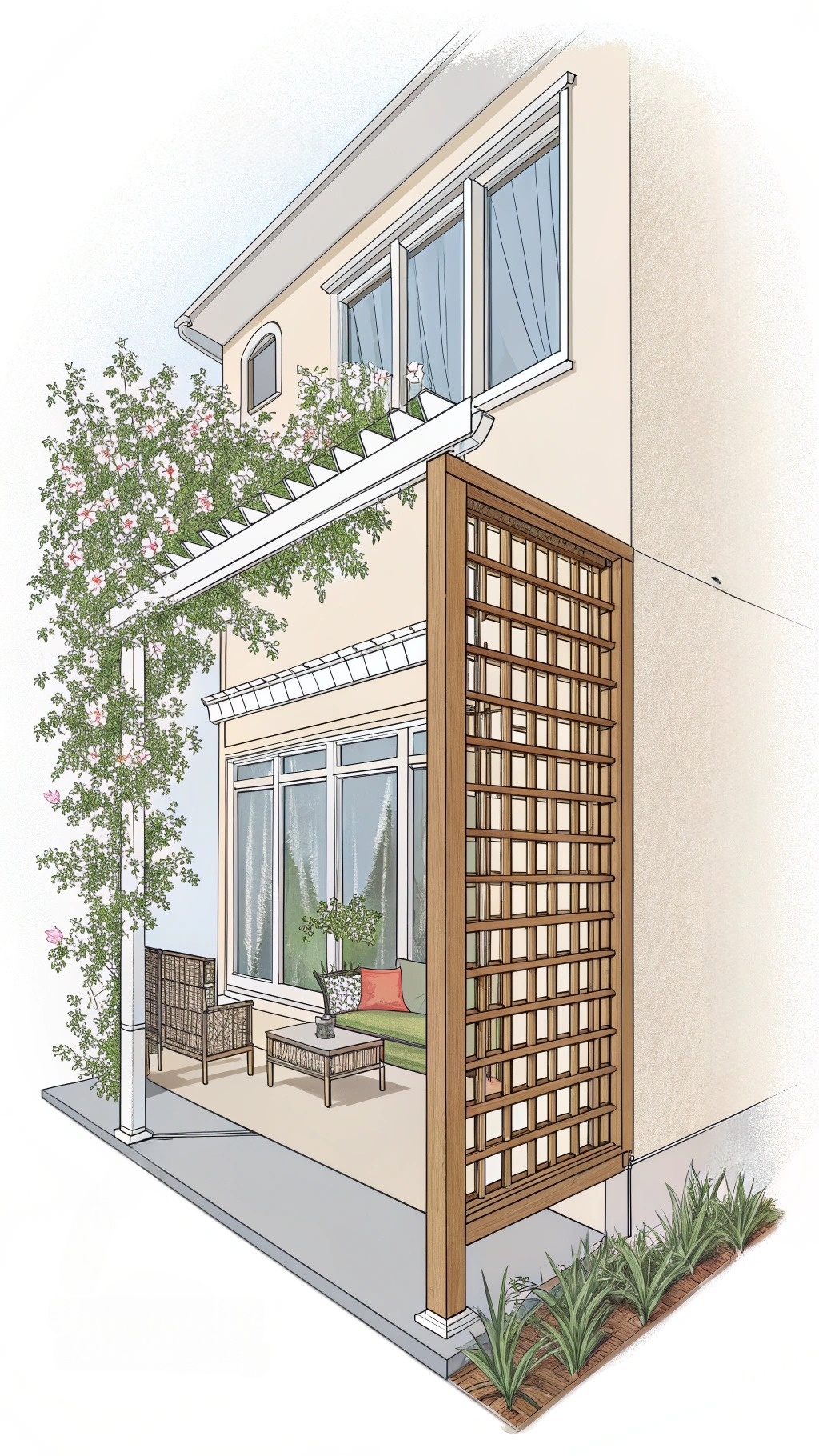
So, how does a structure full of holes actually create privacy? It’s simple geometry, really. Think about where you need privacy most. Is it on your patio? Maybe looking out from your kitchen window? Or perhaps shielding your view from a neighbor’s second-story deck?
First, figure out the specific sightlines you want to block. Sit in your usual spot on the patio. Stand at the window. Where are the gaps in your current privacy? Note the height and angle of view. A well-placed trellis doesn’t need to be a massive wall. It just needs to interrupt that direct line of sight from the observer to you. Even a relatively narrow, tall trellis panel can block a specific window view. Or a lower, wider one can screen your seating area from next door.
Trellises offer big wins beyond just blocking views. Solid fences stop airflow. They can make your patio feel stuffy on hot days. But trellises let the air move! Those openings allow breezes to circulate, keeping things cooler. They also let sunlight filter through. Your yard won’t feel dark and gloomy. Plants behind the trellis still get light.
These vertical structures even tweak the microclimate. A vine-covered trellis absorbs and reflects less heat than a solid wall or fence, especially dark-colored ones. It can make sitting nearby much more comfortable. Some designs can also act as gentle wind baffles. They slow down gusty winds without stopping airflow completely. It’s a softer approach to controlling the elements.
And here’s a bonus: neighbors often prefer looking at a green, leafy screen over a solid fence. A trellis covered in flowering vines looks intentional. It looks like gardening, not walling-off. It adds beauty to both yards. It’s a landscape feature, not just a barrier. It helps define your outdoor space, creating cozy outdoor rooms without harsh lines.
Frame First: Trellis Materials & Finishes That Last
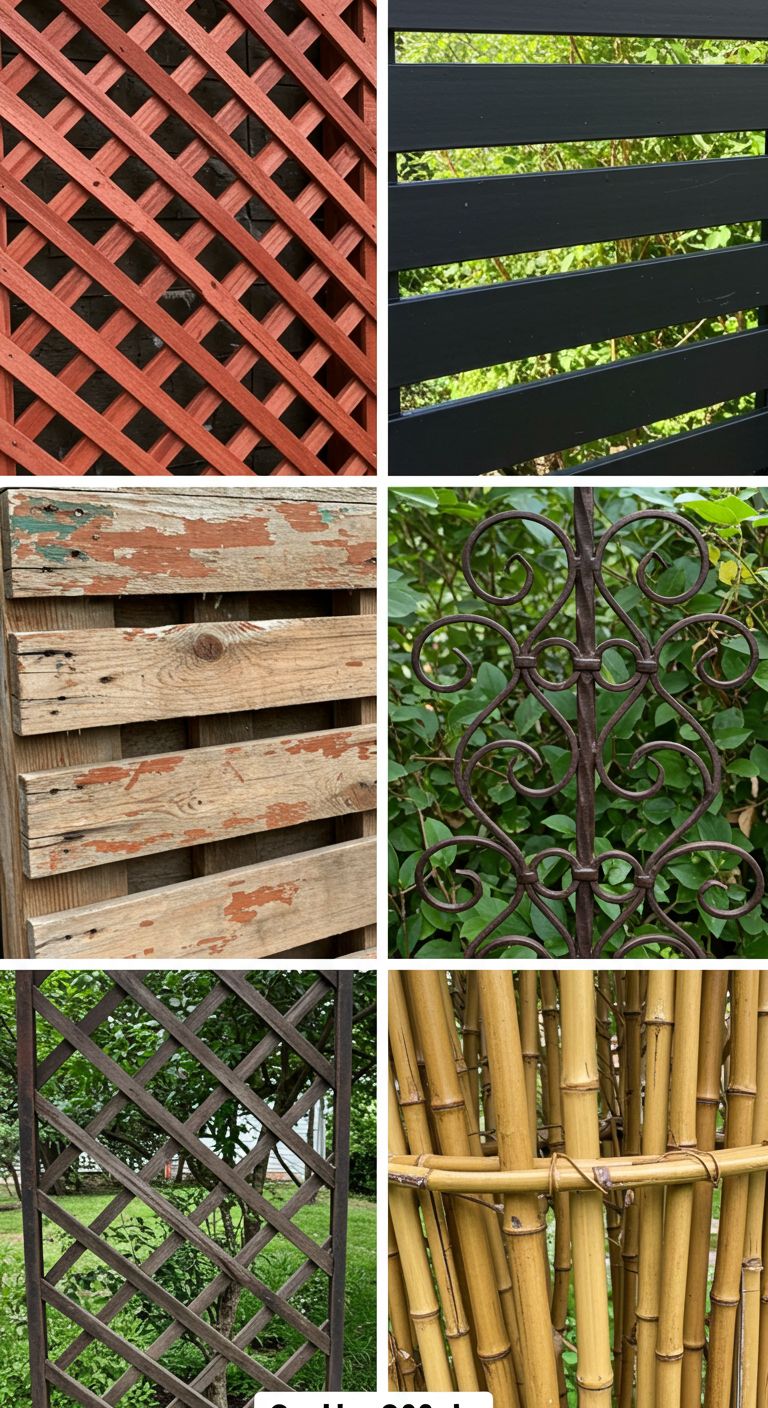
Choosing the right material for your trellis is key. You want something strong. Something that lasts. And something that looks good in your garden.
Timber is a classic choice. Woods like cedar and redwood naturally resist rot and insects. Treated pine is another option, often less expensive. Bamboo canes offer a unique, natural look. Wood feels warm and blends well with plants. But wood needs care.
Metal offers strength and different styles. Powder-coated steel panels are sleek and modern. Wrought iron adds a traditional, fancy touch with scrolls and details. Aluminum kits are lightweight and resist rust. Metal can be very durable. It might cost more upfront sometimes.
Want something unique or budget-friendly? Look at reclaimed materials. Old wooden pallets can be cleaned up and reinforced. Vintage doors or window frames make interesting screens. Even sturdy livestock panels can work, giving an industrial or farmhouse vibe. Get creative!
Whatever material you pick, think about protective finishes. Wood needs stain or sealant every few years. This prevents rot and fading. Metal might need paint touch-ups. Look for rust-resistant coatings, especially for steel or iron. Good finishes extend the life of your trellis significantly. A little upkeep saves money later.
Cost and longevity often go together. Cedar might cost more than pine initially. But it could last much longer with less fuss. Powder-coated metal might seem pricey. But it could outlast untreated wood by many years. Consider your budget and how much maintenance you want to do.
Layout Logistics: Placing a Garden Trellis Divider for Maximum Cover
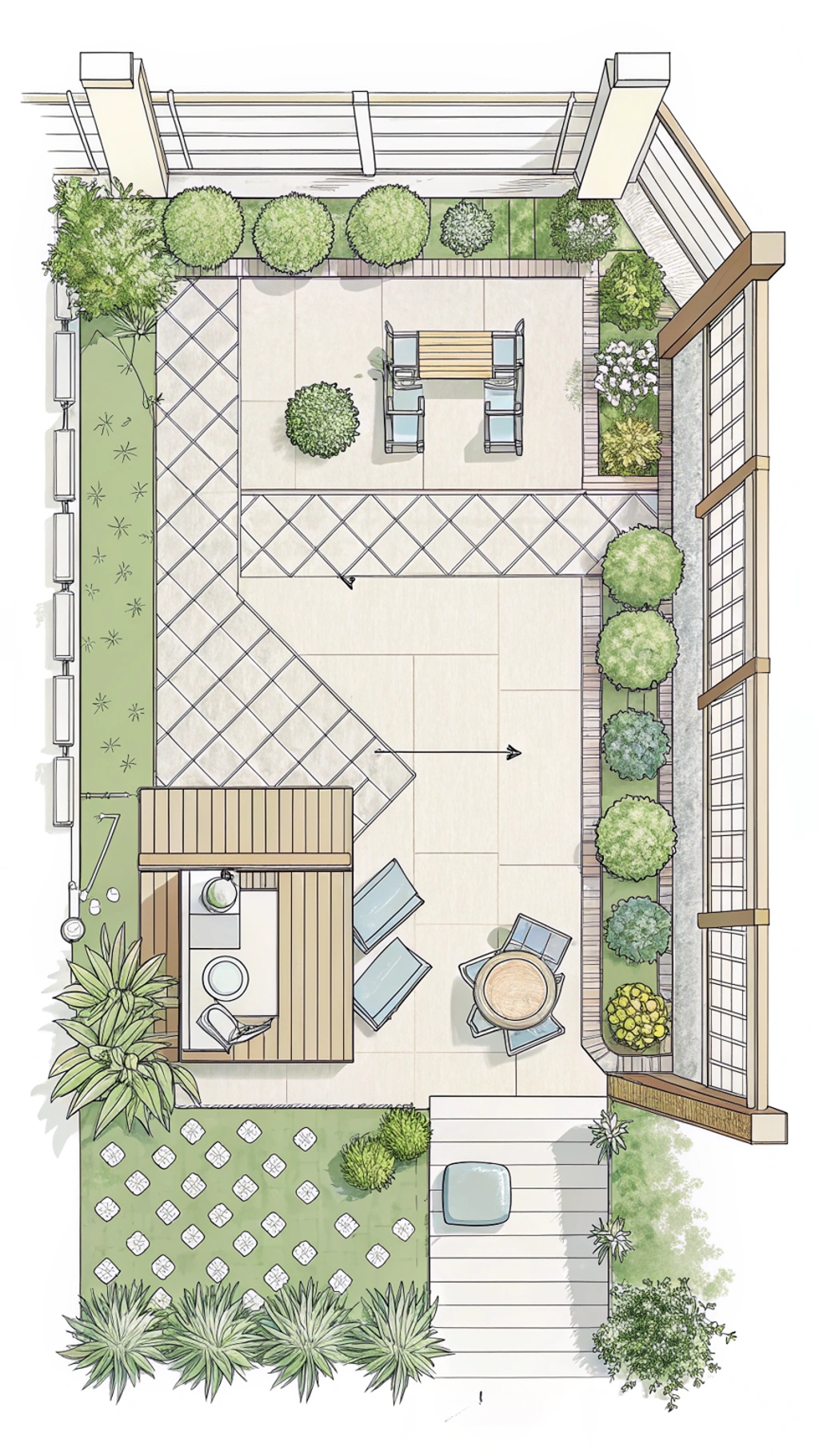
Where you put your trellis matters just as much as what it’s made of. Placement determines how much privacy you actually get. Think like a detective in your own yard.
Start by mapping the sun. Where does it travel across your yard during the day? You don’t want your trellis to block all sunlight from your favorite plants. Or cast your patio in permanent shade. Also, feel the prevailing winds. A well-placed trellis can buffer strong breezes. But a poorly placed one might create annoying turbulence.
Check your local building codes! Many towns have rules about fence height. Sometimes, a trellis attached to the house follows different rules than a freestanding fence. Using stepped heights – taller panels where you need most screening, shorter ones elsewhere – can look good. It might also help you meet code requirements. Be sure before you build.
Secure anchoring methods are vital. A tall trellis catches wind like a sail. It needs to be stable. Setting posts in concrete offers the most strength for freestanding units. Surface-mount brackets can attach posts to existing decks or patios. Heavy planter boxes filled with soil can also anchor smaller trellis panels effectively. Safety first!
Don’t just think in straight lines. Staggering trellis panels creates more visual interest. It breaks up a long, boring line. You can create little privacy rooms or nooks within your yard. Try setting panels at angles or in a zig-zag pattern. This method can block views from multiple directions. It shapes the space in a much softer way than a single, solid wall.
Style Showcase: Ten Garden Trellis Fence Ideas That Double as Art
Your trellis doesn’t just block views. It adds style. It can be a garden feature all on its own. Here are ten ideas to get you inspired.
A. Classic Lattice Privacy Screens
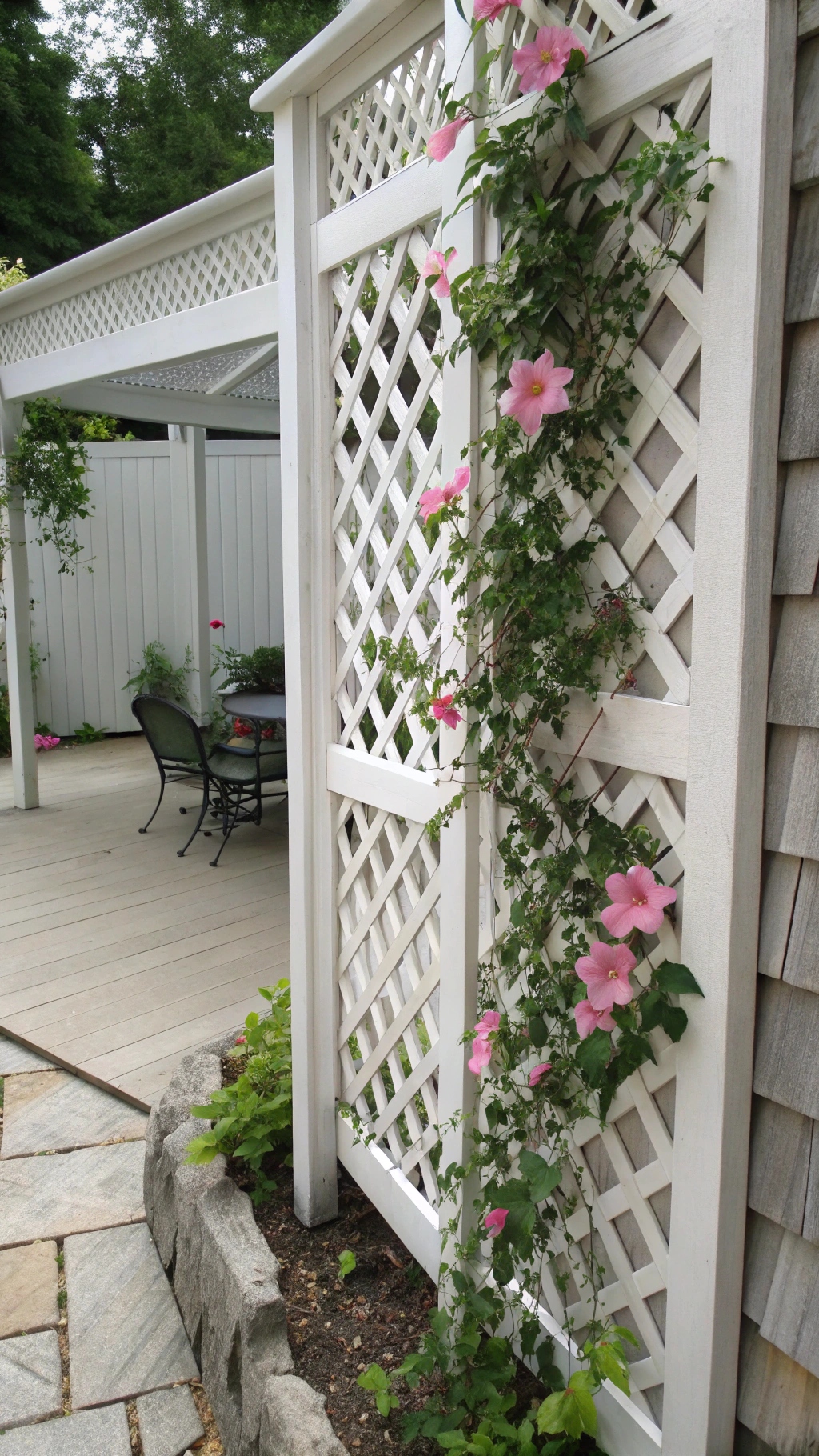
Think traditional diamond patterns. Lattice fence ideas like this are popular for a reason. They look neat and tidy. Choose lattice with small openings, maybe 25mm (about 1 inch) gaps. Smaller gaps mean more privacy right away, even before plants grow. Wood is common, often cedar or treated pine. Paint or stain it to match your house or fence. It’s a timeless look for any yard.
B. Horizontal Slat Panels
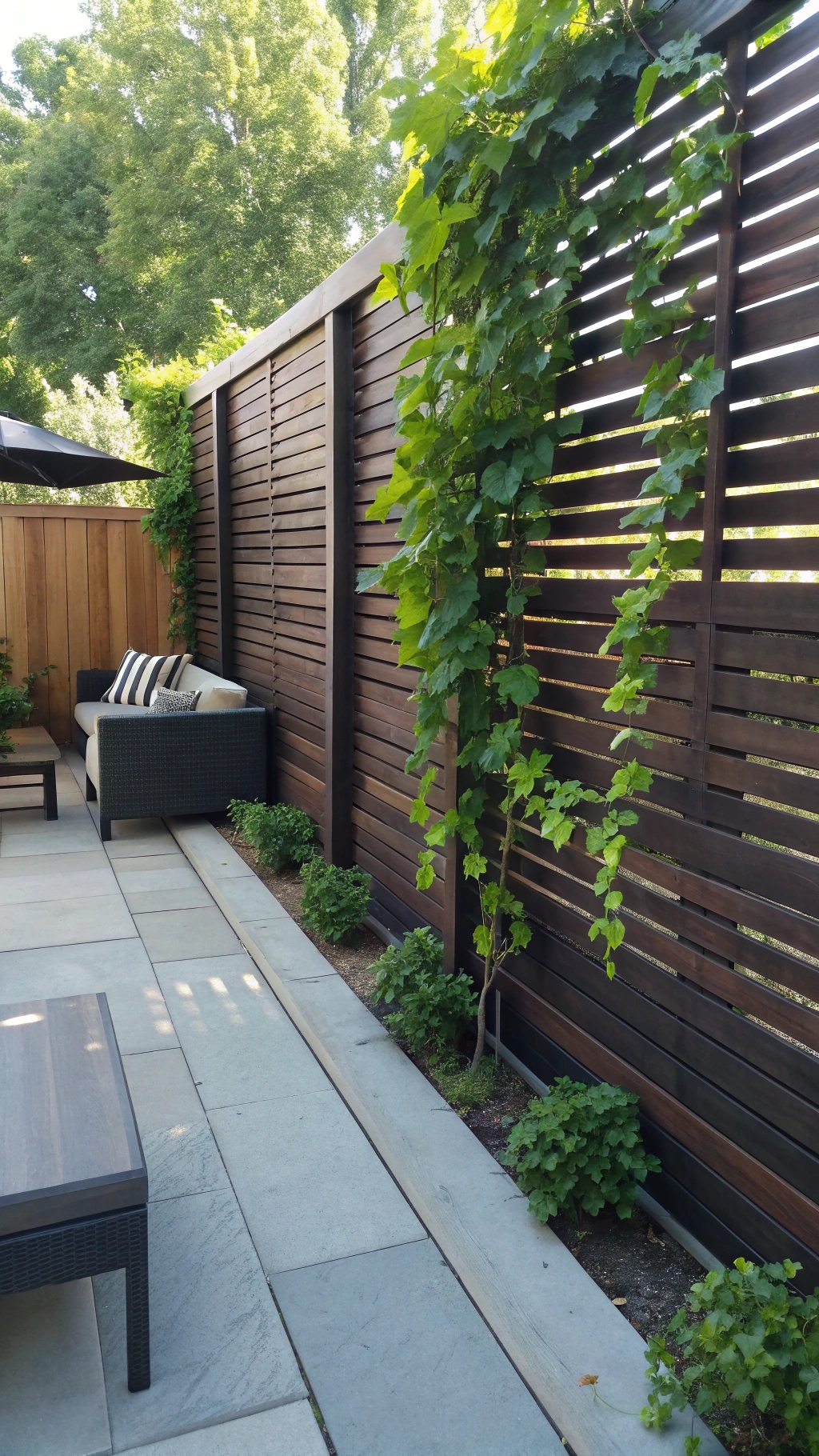
Want a modern feel? Go horizontal. Panels made with evenly spaced horizontal slats look sharp. You can vary the spacing between the slats. Wider gaps let in more light and air. Narrower gaps give more immediate screening. Use stained cedar or composite wood for a rich look. Metal slats work too for an industrial edge. A great yard privacy garden trellis for contemporary homes.
C. Moorish-Inspired Metal Scrollwork
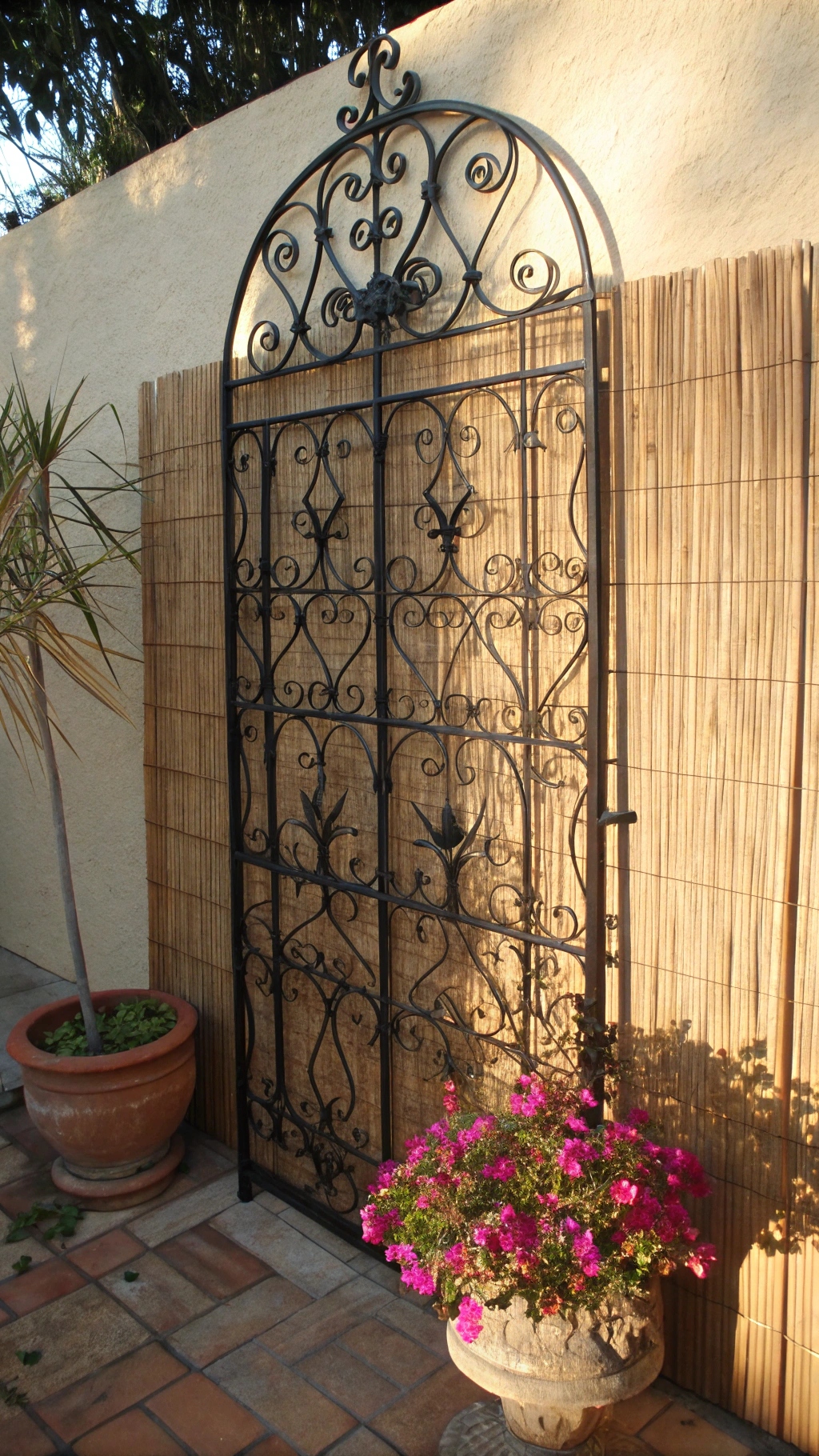
Add some exotic flair. Intricate metal panels with curving, geometric patterns evoke Moroccan gardens. Wrought iron or laser-cut steel creates beautiful shadows. These panels might be quite open on their own. Back them with simple reed or bamboo matting for extra privacy. The combination is stunning. Metal needs proper finishing to prevent rust, especially detailed scrollwork.
D. Living Willow Hurdles

Go truly natural. Willow branches woven together create a rustic screen. You install these living willow hurdles while the branches are flexible, often in late winter or early spring. Push the thicker ends into the ground. If kept moist, they can root and sprout leaves! It creates a dense, green barrier over time. A unique, eco-friendly choice that blends beautifully into a garden setting.
E. Retractable Accordion Trellis
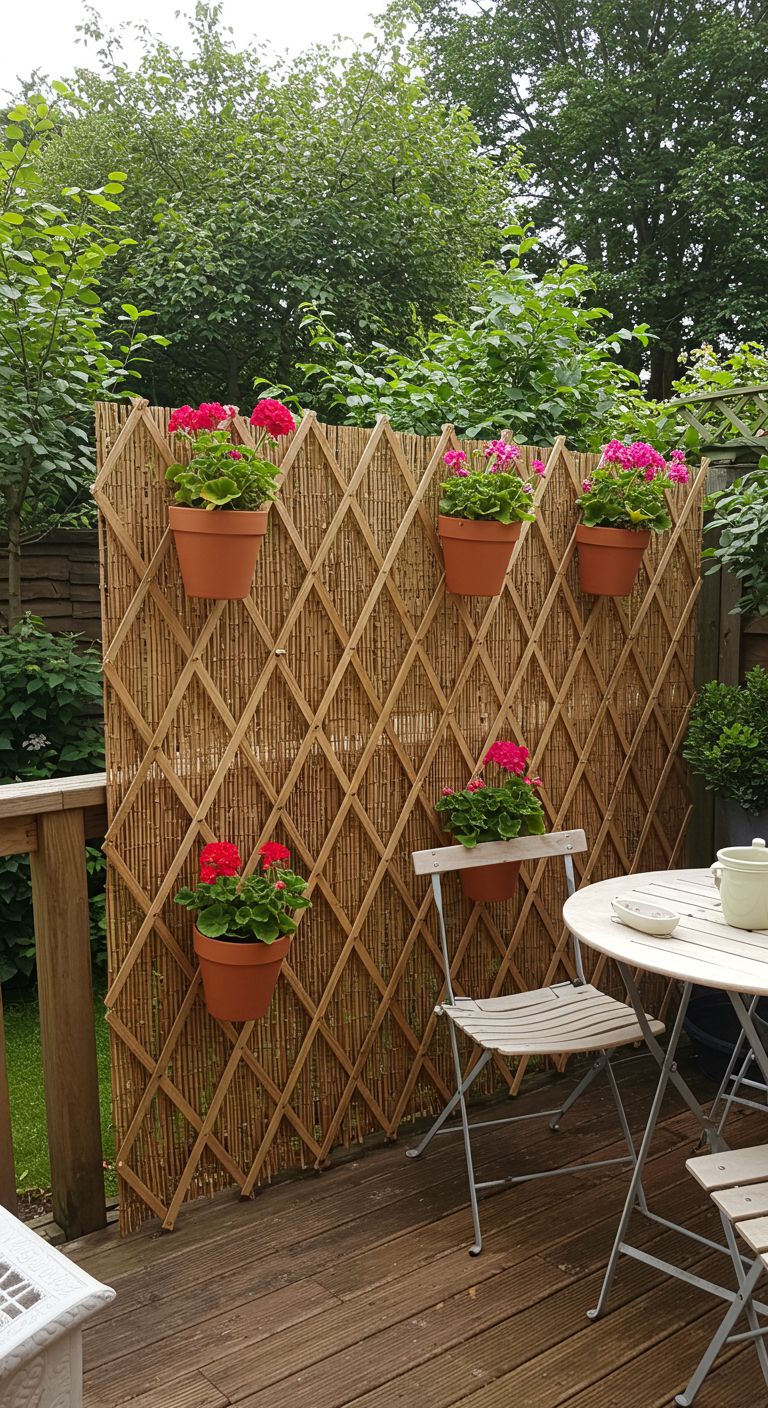
Need privacy sometimes, but not always? Consider a retractable trellis. These often use lightweight wood or bamboo. They expand like an accordion to create a temporary screen. Collapse it when you want an open view. Great for parties or occasional screening needs on a deck or patio. Secure the base well when expanded, as they can be lightweight.
F. Pergola-Top Fence with Climbing Sides
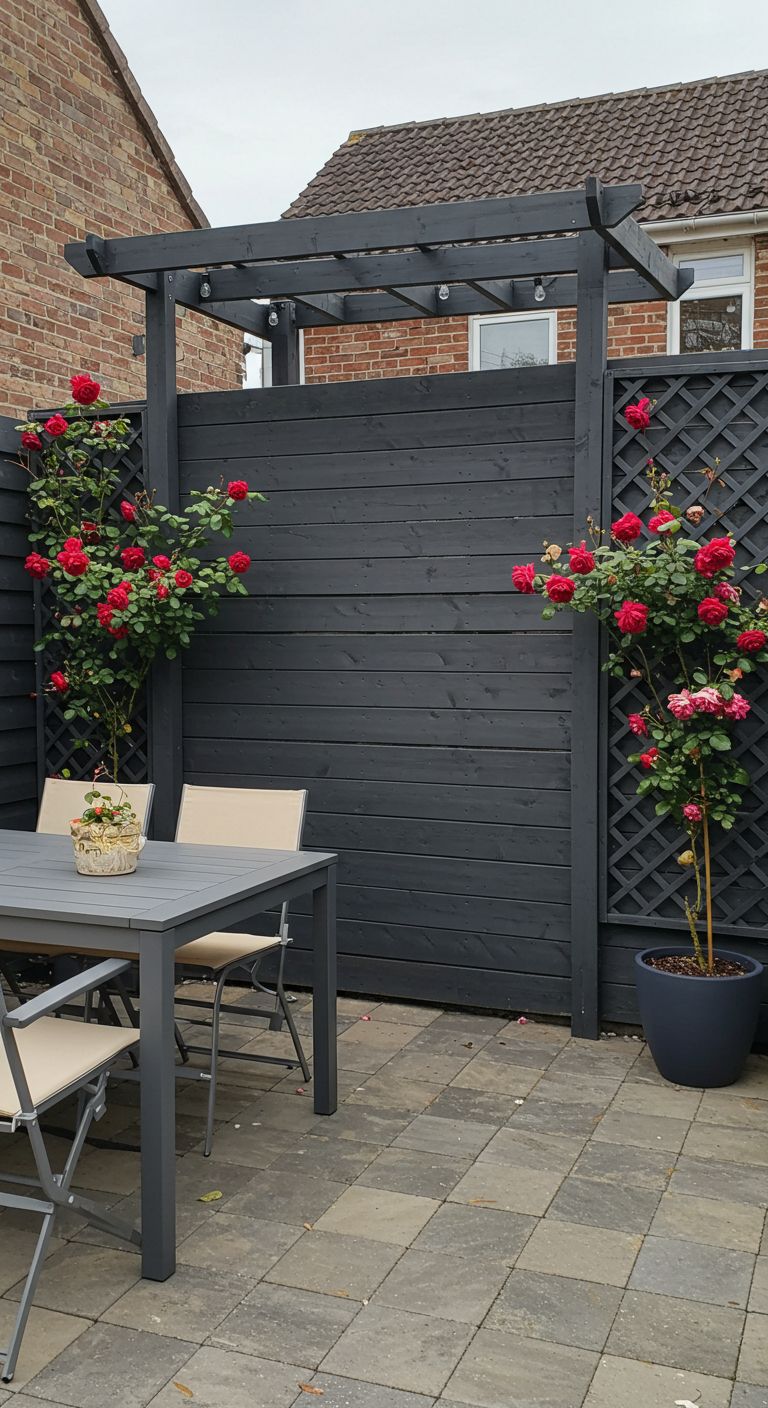
Combine structures for maximum impact. Build a standard fence panel. Then top it with a small pergola-like structure extending outwards slightly. Attach trellis panels to the sides of the fence posts below the pergola top. This creates vertical space for climbers. And the top adds architectural interest. Feels more substantial than just a plain trellis panel.
G. Garden Trellis Screen Ideas for Pool Surrounds
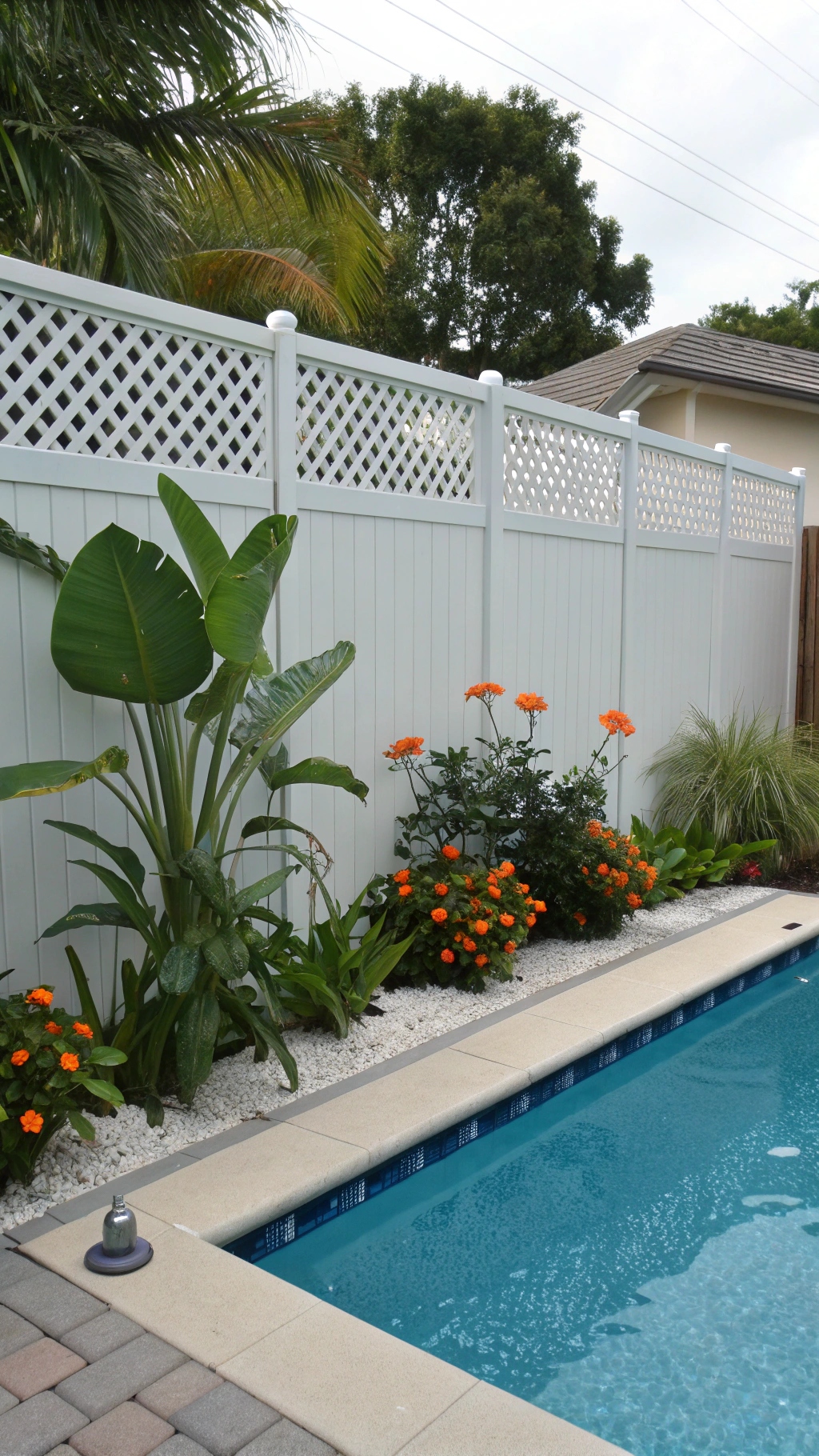
Privacy around the pool is essential. Choose materials that resist moisture and pool chemicals. Powder-coated aluminum or stainless steel are excellent choices. Vinyl or composite lattice also holds up well. Ensure all hardware (screws, brackets) is corrosion-resistant too. Horizontal slats or simple grid patterns often complement modern pool designs. Safety and durability are key here.
H. Mixed-Height “Wave” Fence
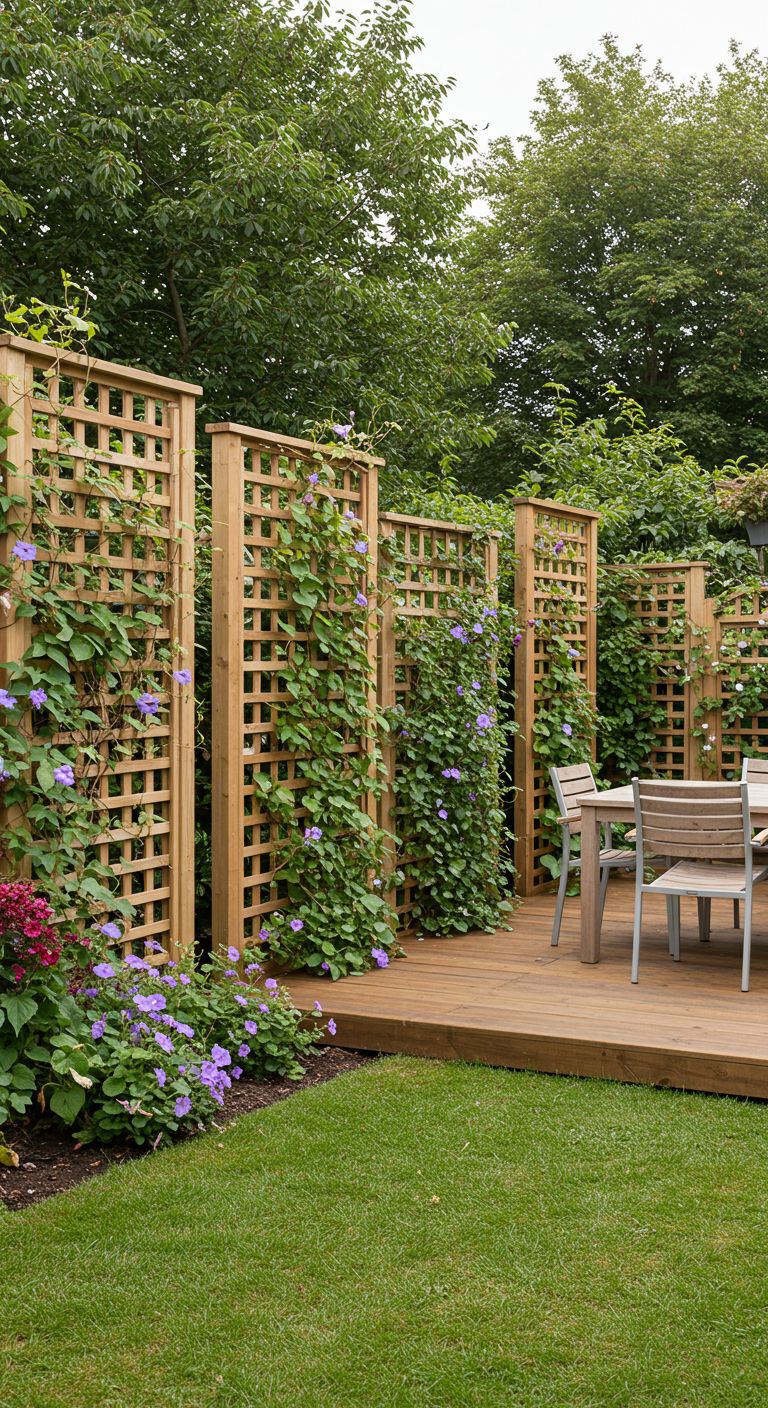
Break up the monotony of a straight line. Use trellis panels of varying heights arranged in a flowing, wave-like pattern. For example, alternate 6-foot panels with 4-foot panels. Or create a gentle curve rising to a peak and then lowering again. This adds visual rhythm. It also allows you to customize screening precisely where needed most, while keeping other areas more open.
I. Corner L-Shaped Panel
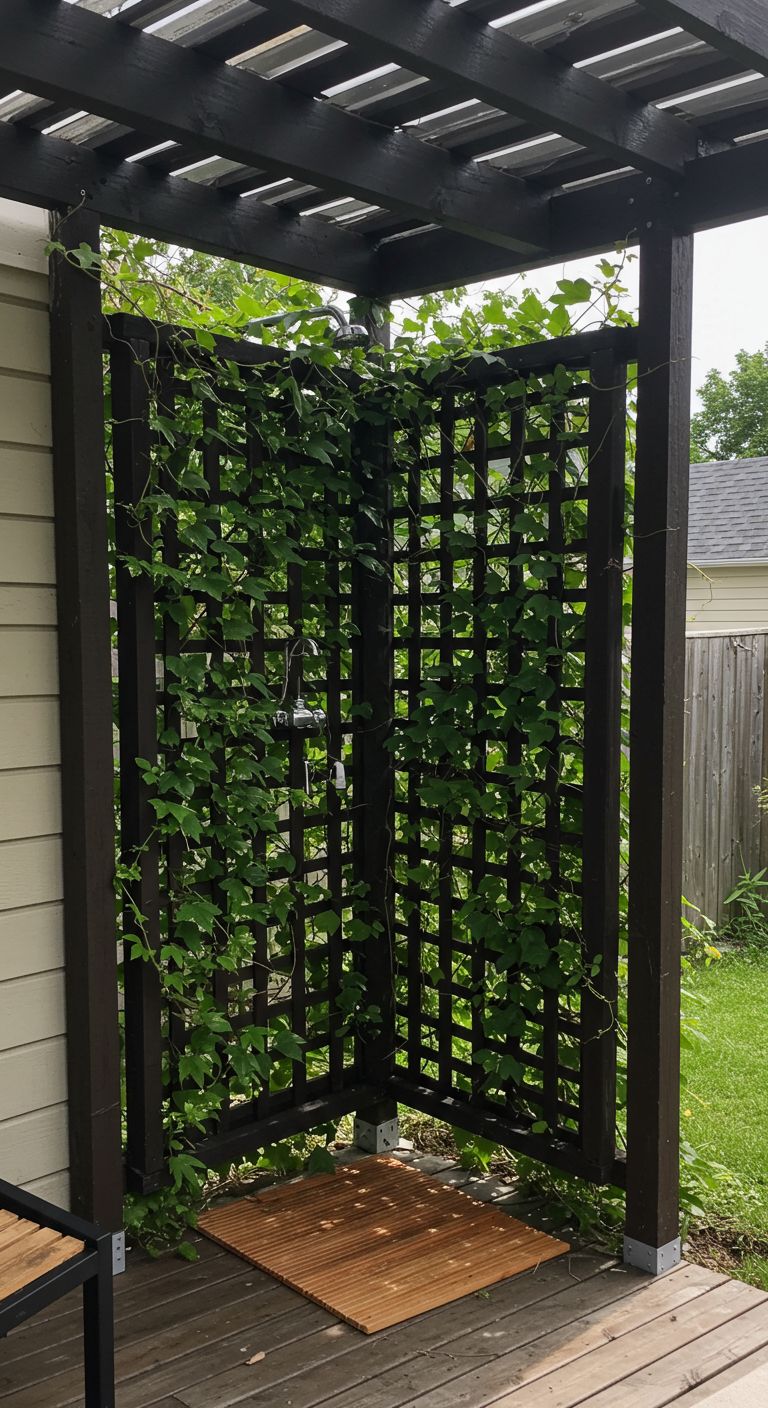
Create an instant private nook. Use two trellis panels joined at a right angle. This Dutchman’s Pipe vine covers much of the lattice, is perfect for tucking away utility areas like trash cans or AC units. Or use it to create a cozy outdoor shower space. Or define a small seating corner on a larger patio. It provides screening from two directions effectively. Anchor it securely at the corner and ends.
J. Hanging-Pot Trellis Wall
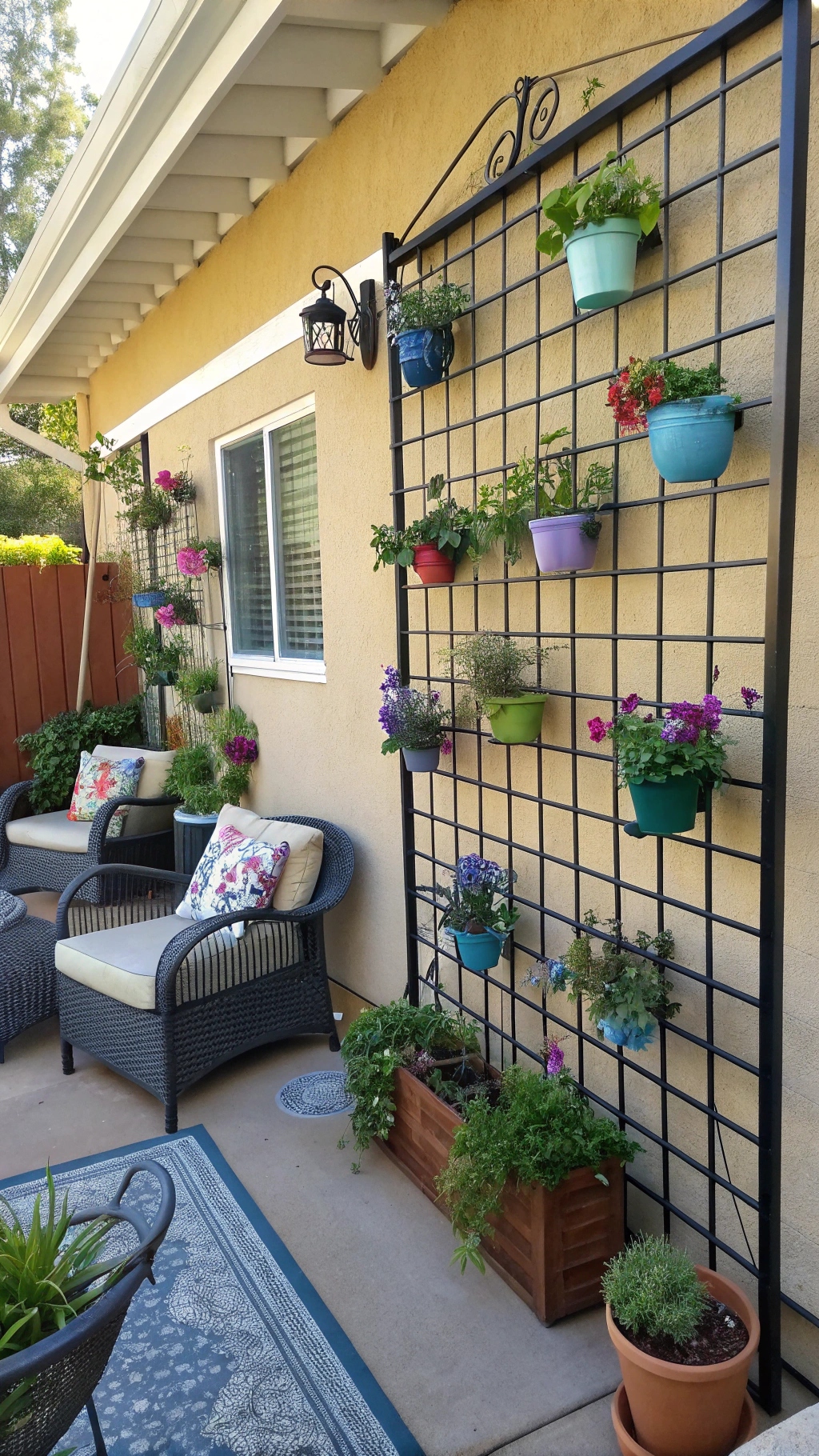
Combine screening with container gardening. Use a sturdy trellis grid – metal mesh or reinforced wood lattice works well. Attach hooks or rings designed to hold small to medium-sized pots. Fill the pots with herbs, trailing flowers, or even strawberries. Creates a beautiful living wall. Provides dappled privacy while keeping your favorite plants close at hand. Ensure the trellis can support the weight.
Plant Partners: Climbers & Companions for a Dense Garden Trellis Privacy Screen
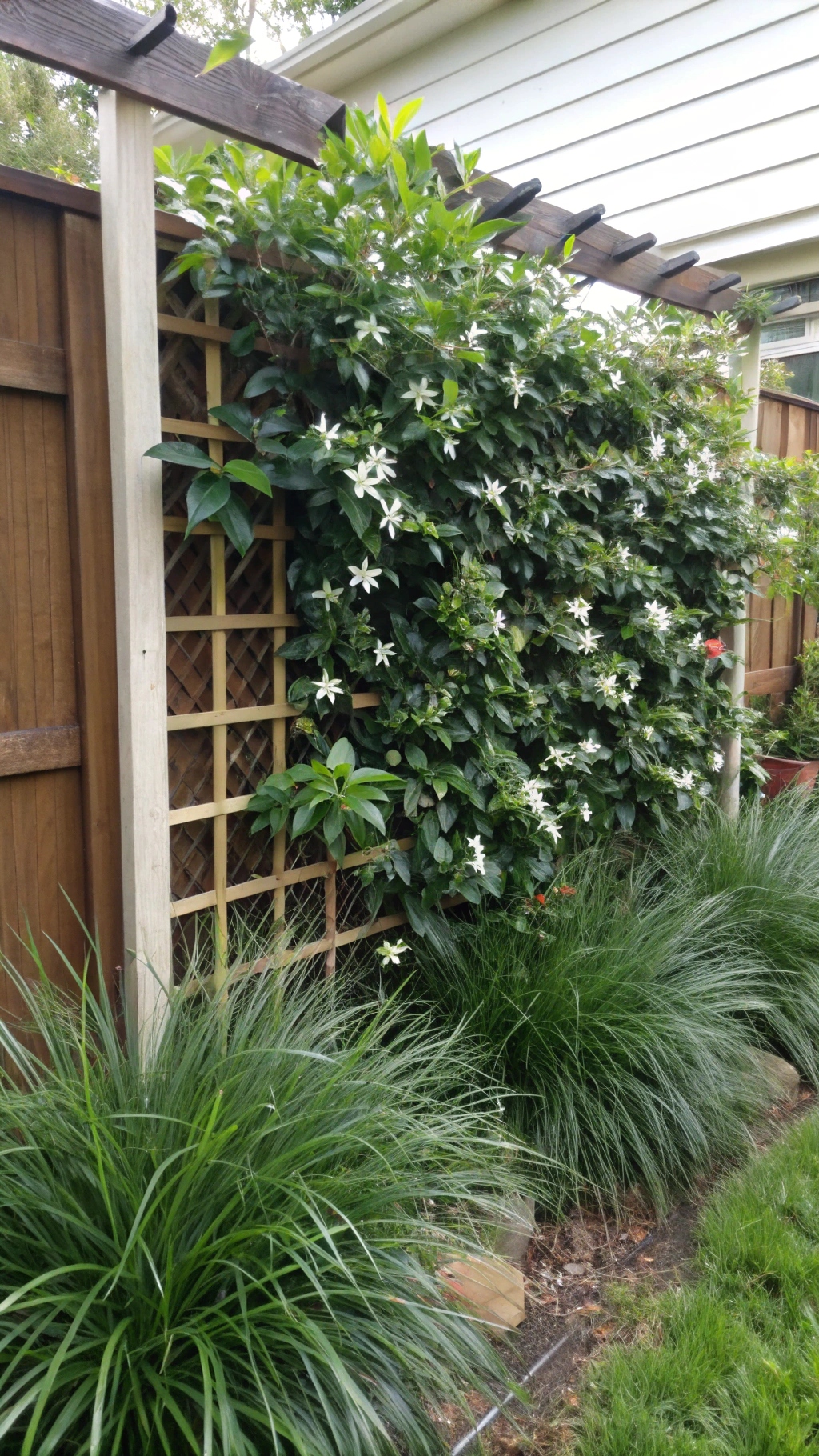
A trellis provides the frame. Plants provide the real coverage. Choosing the right climbers makes all the difference in creating a lush, dense garden trellis privacy screen.
Need privacy fast? Look to speedy annual vines. Scarlet runner beans shoot up quickly, offering nice red flowers and edible beans. Morning glories provide cheerful blooms but can sometimes self-seed aggressively. Hyacinth bean vine has beautiful purple stems, flowers, and pods. These cover fast in one season but die back in winter.
For year-round screening, you need evergreen climbers. Star jasmine (Trachelospermum jasminoides) is a favorite. It has glossy dark leaves and incredibly fragrant white flowers. Some varieties of Clematis are evergreen. Creeping fig (Ficus pumila) clings tightly but can be aggressive on some surfaces. Evergreens provide coverage even when dormant.
Want lovely scent, especially in the evening? Plant fragrant evening cover. Honeysuckle offers classic sweet fragrance loved by hummingbirds. Night-blooming jasmine (Cestrum nocturnum) releases intense perfume after dark. Place these near patios or windows where you can enjoy the scent.
Your trellis can feed you too! Consider edible options. Grape vines provide shade, privacy, and fruit. Passionfruit vines offer stunning flowers and tasty fruit in warmer climates. You can even train cucumber or small melon vines up a sturdy trellis for a vertical vegetable garden.
Don’t forget the base! Sometimes vines are thin at the bottom. Layering plants at the foot of the trellis fills low gaps. Ornamental grasses like Feather Reed Grass add vertical texture. Shade-tolerant perennials such as Hostas or Ferns work well if the trellis casts shade. This layered approach ensures privacy from top to bottom.
Patio Ideas: Garden Trellis Ideas Patio Privacy in Small Spaces
Got a small patio? A balcony? Even a tiny rooftop space? You can still create privacy. Trellises are perfect for tight spots. They go vertical. They don’t eat up valuable floor space. Here are a few garden trellis ideas patio privacy solutions for compact areas.
Case Study 1: Balcony Planter Boxes with Bolt-On Lattice
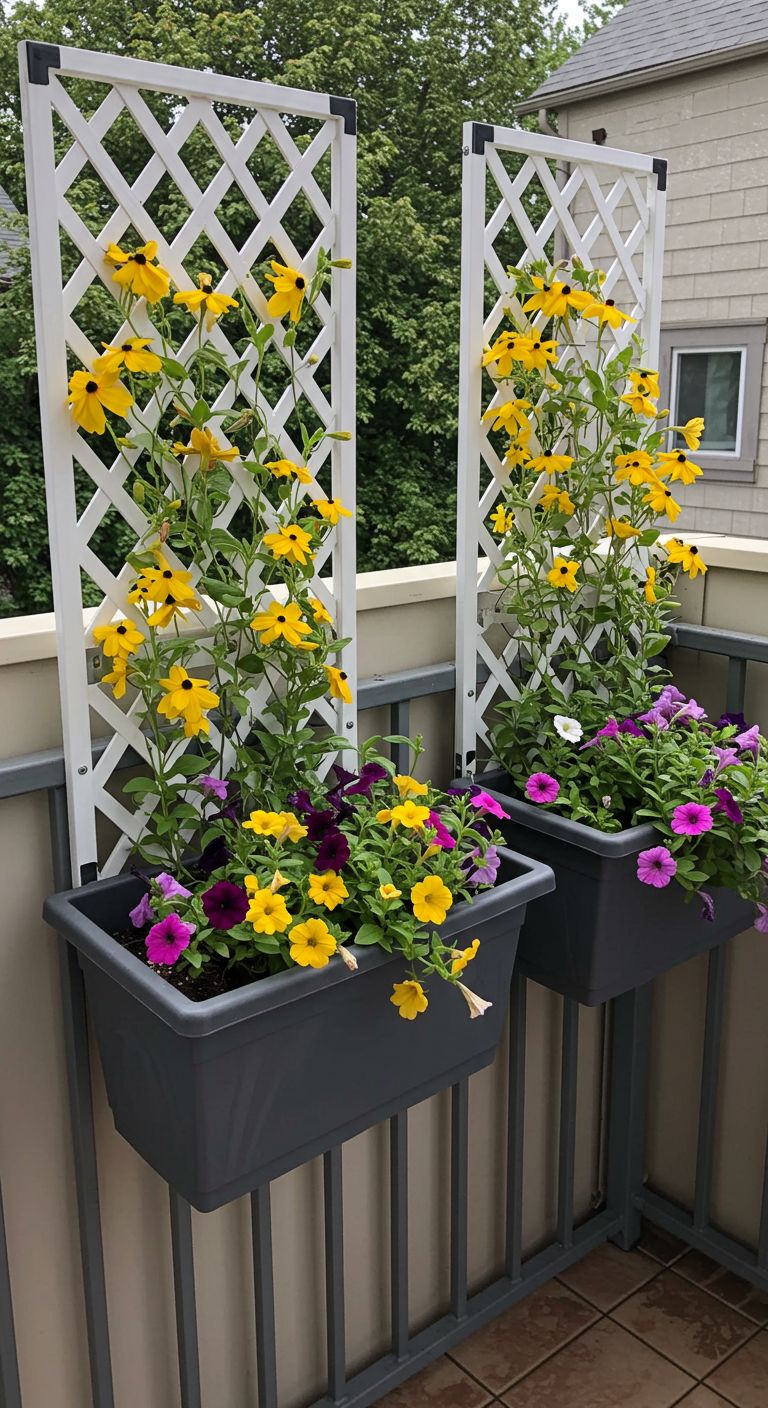
Imagine a standard apartment balcony. Space is tight. You can’t dig into the ground. Solution? Use sturdy, deep planter boxes as anchors. Choose boxes made of wood or thick composite material. Bolt simple wood or vinyl lattice panels directly to the back of the boxes. Plant tall grasses like ‘Karl Foerster’ Feather Reed Grass or annual vines like Black-Eyed Susan Vine in the boxes. The plants grow up the lattice. You get screening without permanent changes. Weight from soil and plants helps stability.
Case Study 2: Café-Style Bistro Nook Shielded by a Fold-Over Cedar Screen
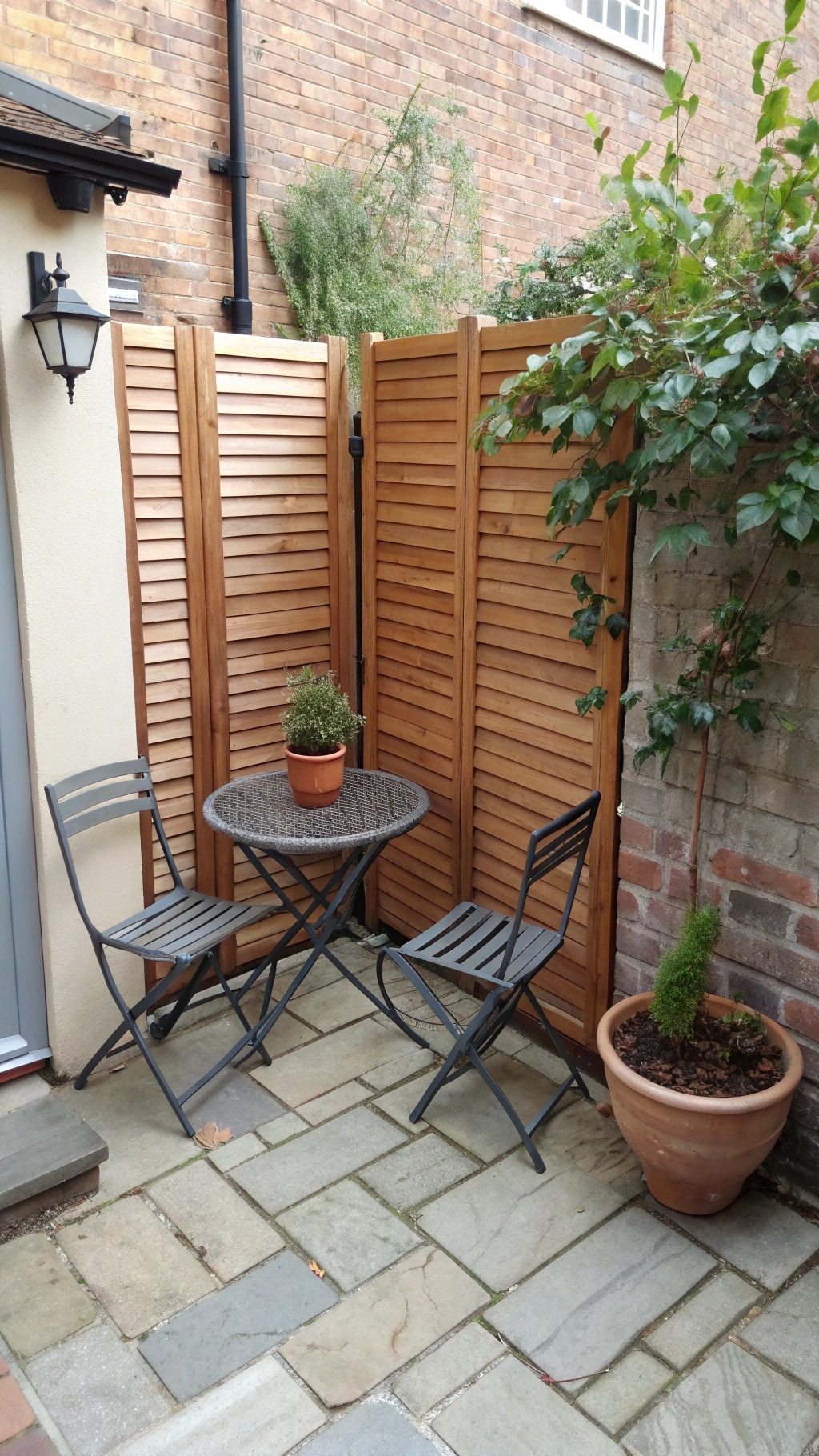
Picture a small corner on a ground-floor patio. Just enough room for a tiny bistro table and two chairs. Make it feel intimate. Build or buy a simple, hinged screen. Two or three narrow cedar panels joined with hinges work well. Use horizontal slats for a modern look. You can fold or angle the screen exactly where needed. Block the view from the path. Or shield the morning sun. Stain the cedar a warm colour. Plant a tall, narrow shrub like Sky Pencil Holly in a pot nearby to soften the edge.
Case Study 3: Rooftop Deck Using Metal Mesh Plus Fabric Inserts
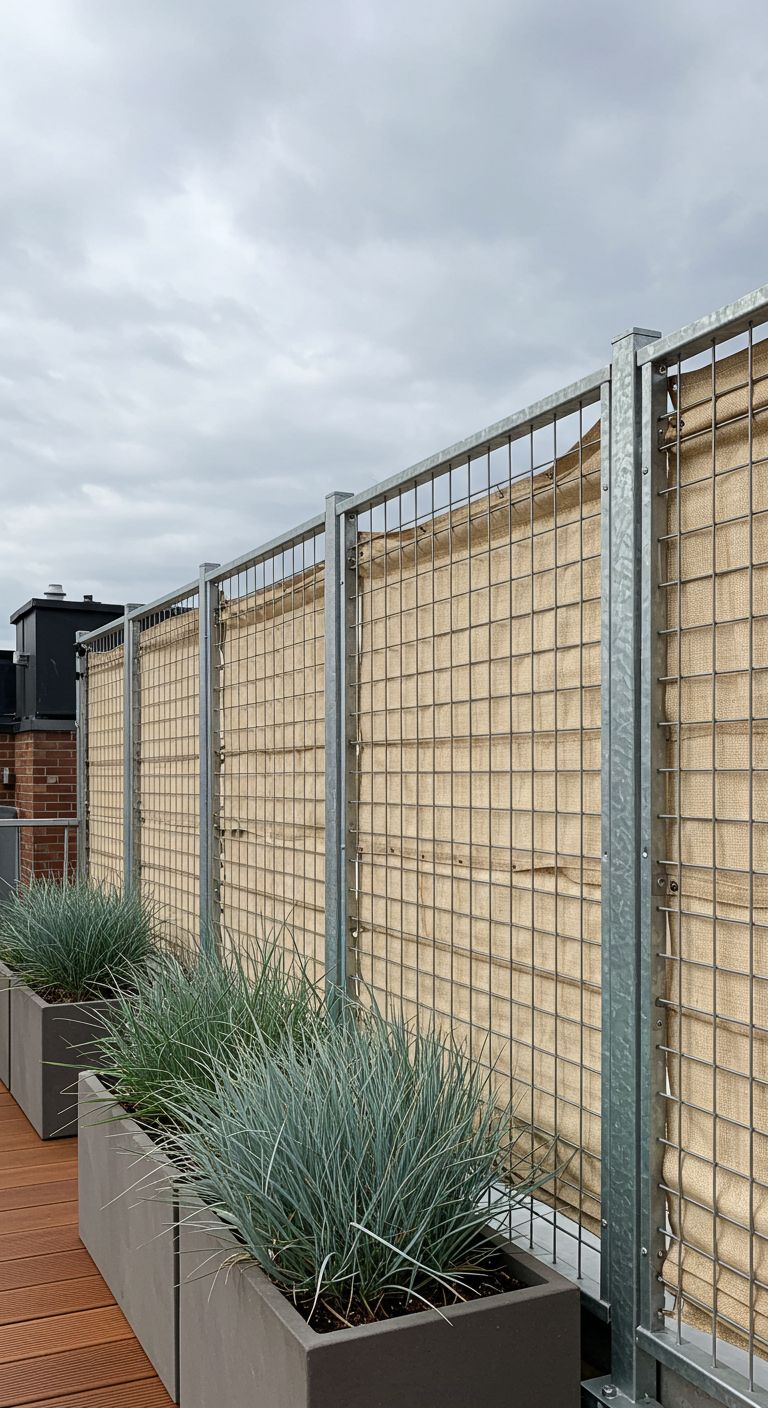
Rooftop decks often deal with wind and wide-open views. Solid panels can act like sails. Try using sturdy metal mesh panels instead. Think heavy-gauge wire grid or expanded metal sheets in frames. These allow wind to pass through. For more privacy or sun blocking, add outdoor fabric. Weave durable, UV-resistant fabric strips through the mesh. Or create simple fabric panels with grommets. Hook them onto the mesh frame as needed. Remove or roll up the fabric in high winds. Plant tough grasses like Switchgrass in containers nearby.
Weekend Workshop: Garden Trellis Ideas DIY Privacy Screens
Feeling handy? You can build your own trellis screen! Garden trellis ideas diy privacy screens don’t have to be complicated. Start simple. Save money. Get exactly the size and style you want. Here are a few project ideas.
Measuring & Sketching Your Divider
First, decide where the screen will go. Measure the length and height you need. Sketch your idea. A simple drawing helps visualize the final look. Note down the measurements. Consider how you’ll anchor it. This planning saves headaches later. Think about sightlines again. Where does the screen need to be tallest?
Building a Pallet-Frame Trellis Step-by-Step
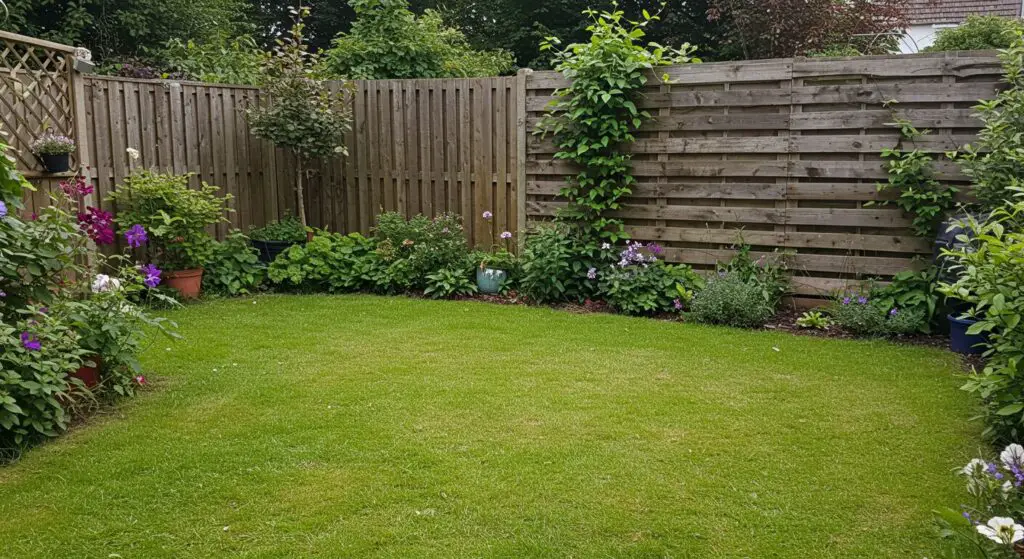
Wooden pallets are often free. Find sturdy ones marked “HT” (heat treated), not “MB” (methyl bromide treated).
- Clean the pallet well. Sand rough spots.
- Pry off every other slat on one side for a more open look, if desired. Or leave them all for more privacy.
- Reinforce weak joints with screws or L-brackets.
- Attach sturdy wooden posts (like 4x4s) to the sides using lag bolts. Make the posts long enough to sink into the ground or attach to anchors.
- Sink posts into concrete or use heavy-duty post anchors.
- Stain or paint the pallet and posts to protect the wood.
Converting Two Reclaimed Doors into a Hinged Screen
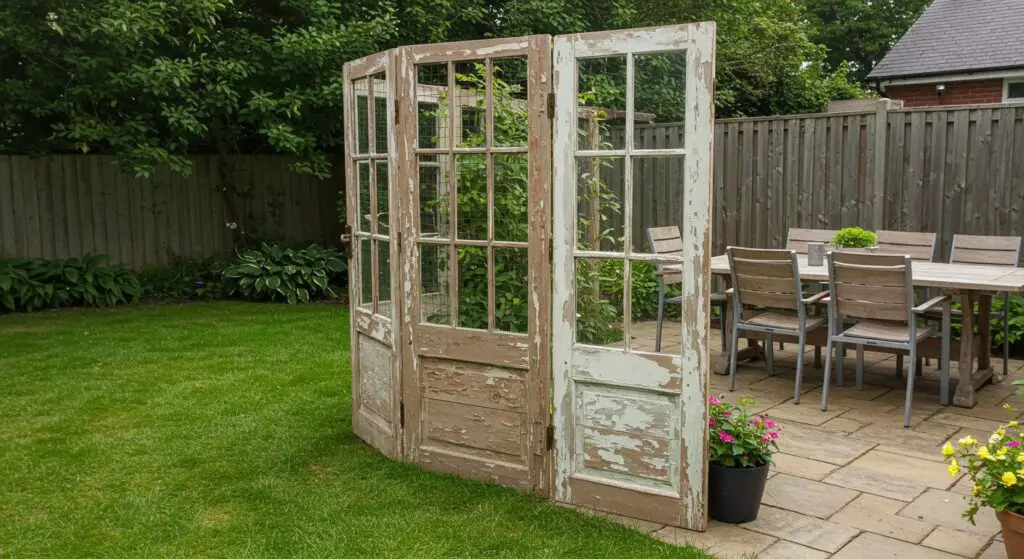
Old doors have character! Find two solid wood doors of similar size.
- Remove hardware (knobs, hinges, locks). Fill holes with wood filler.
- Clean and sand the doors. Paint or seal them.
- If doors have glass panels, consider replacing glass with decorative metal mesh or thin lattice sheets for safety and style. Attach mesh/lattice from behind with trim molding.
- Stand the doors side-by-side. Mark hinge placements (usually three per seam).
- Attach sturdy outdoor hinges to connect the doors.
- Stand the hinged screen up. Angle it for stability or add simple feet/braces at the bottom.
Simple Welded-Wire Panel Between Steel Poles

Get an industrial or modern farmhouse look. Use rigid welded-wire mesh, often sold for fencing or concrete reinforcement.
- Buy a panel of mesh in the size you need. Or cut it carefully with bolt cutters (wear eye protection!).
- Get two metal poles (like chain-link fence posts or rigid electrical conduit).
- Set the poles securely in concrete, spaced correctly for the mesh panel width. Ensure they are perfectly vertical.
- Attach the wire mesh panel to the poles using fence wire, zip ties rated for outdoor use, or specialized metal clips/brackets.
- Plant climbing vines at the base. The mesh gives them perfect support.
Tool List & Safety: You’ll likely need a tape measure, level, drill, screws/bolts, saw (hand or power), sander, safety glasses, and gloves. For concrete work, add a shovel, bucket, and concrete mix. Always work safely. Get help lifting heavy items. Double-check measurements before cutting.
Care Calendar: Keeping Trellises & Vines Looking Sharp
A little upkeep goes a long way. Your trellis and the plants climbing it need some regular attention. Don’t worry, it’s usually not hard work. Think of it as tending your living privacy shield.
Seasonal pruning is probably the biggest task. For many vines, cutting them back helps them grow denser. Pruning encourages more branching. That means thicker foliage and better screening. The best time depends on the plant. Many flowering vines are pruned after they bloom. Some are pruned in late winter or early spring before new growth starts. Check specific advice for your chosen climbers. Trim away any dead or damaged branches anytime you see them.
Help your vines climb where you want them. Gently guide new shoots onto the trellis structure. Use soft training ties, like garden twine or stretchy plant ties. Avoid tight wire that can cut into stems as they grow. Simple plastic clips also work well for some plants. Tuck and weave stems through the trellis openings.
If you have a wood trellis, plan on re-staining or sealing it every 2–3 years. Sun and rain weather the wood over time. A fresh coat protects it from rot and keeps it looking sharp. Check the manufacturer’s instructions for your specific stain or sealant. Metal trellises might need occasional touch-ups if paint chips or rust appears.
Always spot-check anchors after strong winds or heavy storms. Make sure posts are still solid in the ground. Check that brackets holding the trellis are tight. A wobbly trellis is unsafe. Catching problems early prevents bigger damage later. Keep the base area clear of weeds that might compete with your climbers.
Final Thoughts: Privacy with Personality
See? Creating privacy doesn’t mean building boring walls. A thoughtfully placed garden trellis privacy idea adds so much more. It brings life, texture, and style to your yard. It filters light beautifully. It lets breezes through. And it gives you that secluded feeling you crave.
You don’t have to build the ultimate screen all at once. Start with one section. Maybe screen that patio corner first. Or block the view from that one window. Choose a simple trellis design and a few easy-to-grow vines. Watch how it changes the feel of your space.
Your trellis screen will evolve. Plants grow thicker season by season. You might decide to add another panel later. Or try different climbing plants next year. It becomes part of your garden’s living personality. It’s privacy that grows with you. Now go pick a spot and start planning your green screen! Look for our upcoming guides on the best fast-growing vines and how to prune them like a pro.
